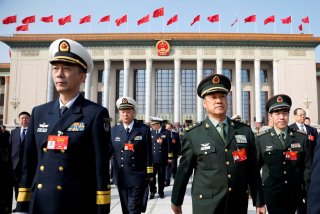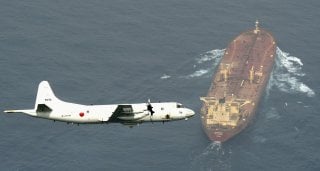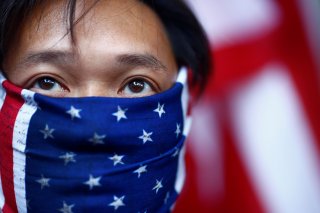
The resulting submarine is according to the U.S. Navy ten times quieter over the full range of operating speeds than the Improved Los Angeles submarines, and an astonishing seventy times quieter than the original Los Angeles–class submarines. It can run quiet at twice the speed of previous boats.
The Seawolf-class submarines were envisioned as the best submarines ever built. Designed to succeed the Los Angeles–class attack submarines and maintain America’s edge in the underwater domain, the class suffered from cost overruns and the collapse of the Soviet Union. While still some of the best submarines ever built, they were built at reduced numbers. In many respects, they are the F-22 of submarines: widely considered the world's best, but costs made wide their wide usage a major challenge.
In the late 1980s, the U.S. Navy was faced with a crisis. In 1980, the Soviet Union had received information from the Walker family spy ring that the Navy could track its submarines through excessive propeller noise. As a result, the Soviet Union went looking for advanced Western machinery to make better propellers. In 1981, the Japanese company Toshiba sold propeller milling machinery—now relatively common nine-axis CNC milling machines—to the Soviet Union via the Norwegian Kongsberg corporation.
By the mid 1980s, the Soviet Union’s new machinery began to make itself felt. The new Akula-class submarines had a “steep drop in broadband acoustic noise profiles”. One government source told the Los Angeles Times, “the submarines started to get silent only after the Toshiba stuff went in.” On top of running silent, the Akula class could dive to depths of up to two thousand feet—while the U.S. Navy’s frontline submarines, the Los Angeles class, could dive to only 650 feet.
To combat the threat of the Akula class, the U.S. Navy responded with the Seawolf class of nuclear attack submarines. The Seawolf submarines were designed with HY-100 steel alloy hulls two inches thick, the better to withstand the pressures of deep diving. HY-100 steel is roughly 20 percent stronger than the HY-80 used in the Los Angeles class. As a result, the submarines are capable of diving to depths of up to two thousand feet, and crush depth estimates run from 2,400 to 3,000 feet.
At 353 feet, Seawolf subs were designed to be slightly shorter than their predecessors, by just seven feet, but with a twenty percent wider beam, making them forty feet wide. This width made them substantially heavier than the subs before them, topping the scales at 12,158 tons submerged.
The Seawolf submarines are each powered by one Westinghouse S6W nuclear reactor, driving two steam turbines to a total of 52,000 shaft horsepower. The class was the first class of American submarine to utilize pump-jet propulsors over propellers, a feature that has carried over to the newest Virginia class. As a result, a Seawolf is capable of eighteen knots on the surface, a maximum speed of 35 knots underwater, and a silent running speed of about 20 knots.
The Seawolf class is equipped with the BQQ 5D sonar system, which features a twenty-four-foot-diameter bow-mounted spherical active and passive array as well as wide-aperture passive flank arrays. The submarines are being refitted with TB-29A thin-line towed array sonar systems. Rounding out sonar systems is the BQS 24, for detection of close-range objects such as mines.
The ship’s original combat data system was the Lockheed Martin BSY-2, which uses a network of seventy Motorola 68030 processors—the same processor that drove early Macintosh computers—and is now being replaced with the AN/BYG-1 Weapons Control System.
The submarines were designed to be true hunters, and as a result have eight torpedo tubes, double the number of earlier submarines. It has stores for up a combination of up to fifty Mark 48 heavyweight torpedoes, Sub-Harpoon antiship missiles, and Tomahawk missiles. Alternatively, it can substitute some of this ordnance for mines.
The resulting submarine is according to the U.S. Navy ten times quieter over the full range of operating speeds than the Improved Los Angeles submarines, and an astonishing seventy times quieter than the original Los Angeles–class submarines. It can run quiet at twice the speed of previous boats.
This formidable increase in performance came at formidable increase in cost. The total Seawolf program was estimated at $33 billion for twelve submarines, an unacceptable cost considering the Soviet Union—and the threat of the Akula and follow-on subs—ended in 1991. The program was trimmed to just three submarines that cost $7.3 billion.
The extreme quietness of the Seawolf class gave the Navy the idea of modifying the last submarine, USS Jimmy Carter, to support clandestine operations. An extra one hundred feet was added to the hull, a section known as the Multi-Mission Platform (MMP). The MMP gives Carter the ability to send and recover Remotely Operated Vehicles/Unmanned Underwater Vehicles and SEALs and diving teams while submerged. It includes berthing for up to fifty SEALs or other attached personnel. Carter also features auxiliary maneuvering devices fore and aft for precise maneuvering in situations such as undersea cable tapping and other acts of espionage.
The Seawolf-class submarines are outstanding submarines, but the Cold War mindset at the time of development accepted high performance and consequently high costs to meet a high-level threat. The post–Cold War Virginia class forced the Navy to reign in costs while still producing a progressively better submarine. While unsuccessful as a class, the tiny Seawolf fleet is still a very useful part of the U.S. Navy submarine force, giving it capabilities not even the Virginia class can match.






